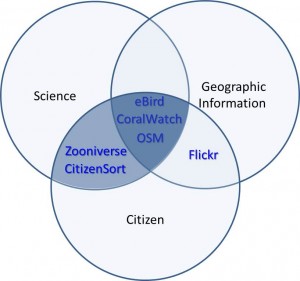While collecting the corpus of relevant papers, we could search most papers with key phrases “Data Quality” and “Citizen Science” or “Volunteered Geographic Information”. The term of citizen science is mostly used in natural science-related fields such as biology, ornithology, and ecology, while volunteered geographic information (VGI) is mostly used in geography as the name stands. We can observe involvement of non-professional scientists in data collection and, to some extent, other related processes (Haklay, 2013) in both phenomena, however clear distinctions also can be found between them. Thus, it is critical to clarify definitions of those phrases and boundaries and intersections of them, and I summarized them for the weekly update for week 6.
Citizen science can be considered various means in which public citizens participate in genuine scientific research from data collection to data analysis (Cooper, Dickinson, Phillips, & Bonney, 2007; Hecht & Cooper, 2014; Shirk et al., 2012; Silvertown, 2009). The internet, Web 2.0 and social networking technologies are promoting web-based social networks which play major roles in building collective intelligence for solving scientific problems (Hunter, Alabri, & Ingen, 2013). What we need to stress in citizen science is that players are citizens and playground in which the players are working is science, as the name stands for. Involvement of citizens is democratization of science from a traditional top-down process, to a revolutionary bottom-up process.
Volunteered geographic information has more varieties in terms of its applications and practices than citizen science has. VGI can span from recreational activities such as geo-registering holiday photographs to Flickr (Turner, 2006) to surveys to produce disaster-relief-related-information aftermath of an earthquake (Zook, Graham, Shelton, & Gorman, 2010). The relevance of VGI to geographical aspect also varies a lot. In case of OpenStreetMap (OSM), volunteers explicitly produce geographic information with the online tool/community. Volunteers’ endeavor in OSM focuses on the creation of geographic data describing verifiable facts about the world which can be observed on the Earth (Haklay, 2013). However, most Flickr users intrinsically produce geographic information by uploading photographs taken by their smartphones equipped with internal GPS units, as photo-sharing social networking services can automatically extract location information from the photographs. The service users can produce geographic information without noticing it. Thus, differentiation in VGI can be made between geographically explicit and implicit volunteered information.
Not all citizen science is geographic, as far as the location on Earth does not affect the process of their scientific inquiries. On the other hand, not all volunteered geographic information is scientific, as some volunteered information is used for recreational purposes as mentioned earlier. In this regard, the notion of geographic citizen science proposed by Haklay (2013) will be helpful to define the subjects of our research. According to Haklay (2013), geographical citizen science encompasses projects where the collection of location information is an integral part of the scientific activities by citizens. In Figure 1, citizen science is an area where two big circles of citizen and science are intersected. VGI is an area where two big circles of citizen and geographic information are intersected. eBird, CoralWatch and OSM are within the area intersected with “Citizen”, “Science” and “Geographic Information”, and this area can be considered geographic citizen science in our definition.
Figure 1: The conception of citizen science and volunteered geographic information
The examples of OSM and Flickr are tricky on whether they can be included within the boundary of science or not, however we consider only OSM as science inasmuch as they are within the field of geographic information science as well as they are geographically explicit. In short, citizen science is a medium-highlighted area which overlaps the two circles of citizen and science, and geographic citizen science is a dense-highlighted area which overlaps the three circles of citizen, science and geographic information. These two intersected areas are the boundaries where our research is searching for data quality assurance mechanisms, although our team needs more discussion for final agreement.
References
Cooper, C. B., Dickinson, J., Phillips, T., & Bonney, R. (2007). Citizen science as a tool for conservation in residential ecosystems. Ecology and Society, 12(2), 11.
Haklay, M. (2013). Citizen science and volunteered geographic information: Overview and typology of participation. Crowdsourcing geographic knowledge (pp. 105-122) Springer.
Hecht, J., & Cooper, C. B. (2014). Tribute to tinbergen: Public engagement in ethology. Ethology, 120(3), 207-214.
Hunter, J., Alabri, A., & Ingen, C. (2013). Assessing the quality and trustworthiness of citizen science data. Concurrency and Computation: Practice and Experience, 25(4), 454-466.
Shirk, J. L., Ballard, H. L., Wilderman, C. C., Phillips, T., Wiggins, A., Jordan, R., . . . Krasny, M. E. (2012). Public participation in scientific research: A framework for deliberate design. Ecology and Society, 17(2), 29.
Silvertown, J. (2009). A new dawn for citizen science. Trends in Ecology & Evolution, 24(9), 467-471.
Turner, A. (2006). Introduction to neogeography O’Reilly Media, Inc.
Zook, M., Graham, M., Shelton, T., & Gorman, S. (2010). Volunteered geographic information and crowdsourcing disaster relief: A case study of the haitian earthquake. World Medical & Health Policy, 2(2), 7-33.

